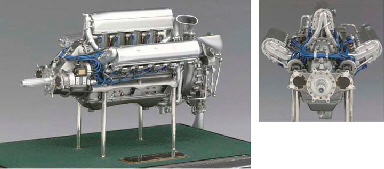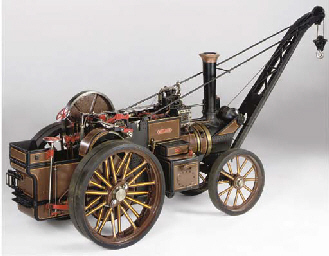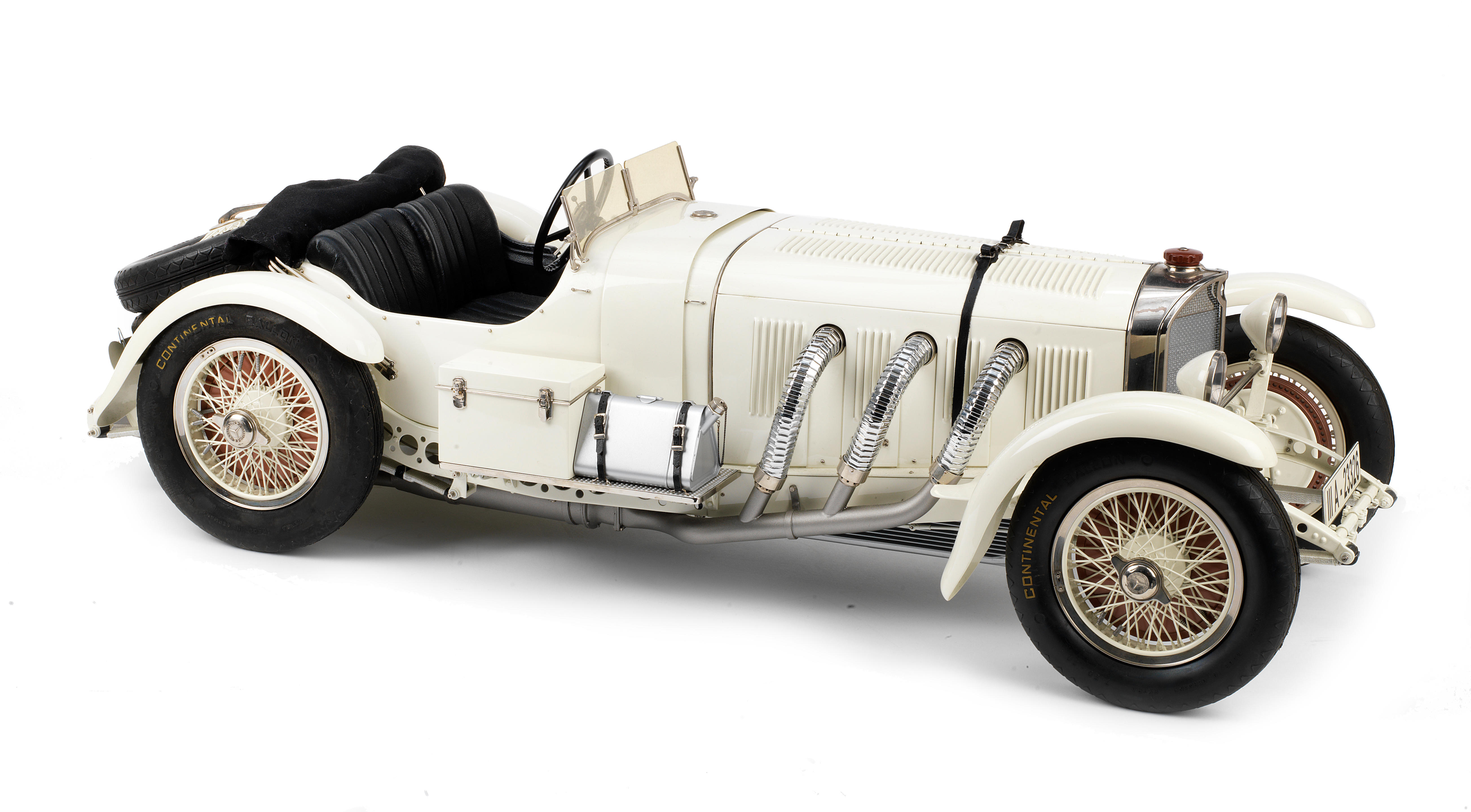A fine and detailed builder's model of the twin screw steam yacht 'Triad' R.Y.S. built by the Caledon Shipbuilding and Engineering Co. Ltd. Dundee for G.A. Shenley Esq. Warsash, Southampton With masts, yard and booms, standing and running rigging and deck details including anchors with 'D' chains, anchor davit and steam winch, bollards, deck rails, companionways, ventilators, deck lights, hatches, superstructure with wood capped rails, framed windows, bridge with ship's wheel, binnacle and telegraphs, fire buckets, stayed funnels with ladders, hooter, siren, and safety valve extention pipe, engine room lights, lockers, steam pinnace, sailing yacht, motor boats and two life boats in davits all with detailed fittings as appropriate. The hull, with twin four blade propellors with bolted blades, is finished in green, white, yellow and varnish with silver plated and laquered brass fittings, mounted on four silver plated columns on mahogany display base. Glass cover (later) -- 26 x 66½in (66 x 169cm) The steam yacht Triad [1,212 tons gross; 440 tons net] was a particularly handsome example of her breed even though, with her distinctive straight stem and two unusually tall slightly raked funnels, her overall appearance was arguably more remniscent of the passenger liners of the day, albeit in miniature form. Designed and built at Dundee by the Caledonian Shipbuilding & Engineering Co. in 1909, her steel hull measured 250 feet inlength, she had a 35 foot beam and she was rigged as a two-masted schooner. Powered by two of Caledonian's own triple expansion engines fired from Scotch boilers producing 409 nominal h.p., her twin screws gave her an excellent turn of speed which merely reinforced that impression of similarity to the great ocean greyhounds of the Edwardian era. Triad was ordered by and built for Mr. G.A. Shenley but he kept her only three years before selling her to Richard Grech. In the summer of 1914, Grech was aboard Triad cruising in the Eastern Mediterrranean and, when War was declared in August, he made for the nearest friendly port and offered her to the authorities for use as an auxilary patrol vessel. In view of her size and speed, the Admiralty did not hesitate to hire her and armed with 2-12 pounders, she entered service with the Royal Navy in February 1915. Based in the Eastern Mediterranean where she had been taken over, she soon found herself needed for the Gallipoli offensive in April 1915 and was sent there soon after the first landings. This campaign, intended to knock Turkey out of the War and thus neutralise one of Germany's strongest allies, was a complex joint operation involving a substantial naval force under the command of Admiral de Robeck. The concentration of capital ships in the Dardanelles however proved a tempting target for German submarines and, on 25 May, the battleship H.M.S. Triumph was torpedoed and sunk by U.21 thereby confirming de Robeck's worst fears. Reluctantly he gave orders for his fleet to disperse whilst at the same time, seeing the need to remain on station, took the rather surprising decision to transfer his flag to the armed yacht Triad which was standing by. With her eminently suitable accomodation and the ability to steam close inshore well away from the submarine menace, Triad suited de Robeck so well that he kept her as his flagship until the abortive campaign was finally abandoned later that year. With her reputation amongst senior naval officers well and truely made, Triad was retained as flagship in the Eastern Mediterranean where she took part in other operations including those in the Agean and the Persian Gulf before the War ended in November 1918. Rather than return her to her peacetime owner, the Admiralty decided to retain Triad and the purchase negotiations were concluded in June 1919. As from 1 January 1920, she became a Special Service Vessel and a wide variety of duties kept her employed until she was sold out of the Navy (from Bombay) in May 1933 after which
A fine and detailed builder's model of the twin screw steam yacht 'Triad' R.Y.S. built by the Caledon Shipbuilding and Engineering Co. Ltd. Dundee for G.A. Shenley Esq. Warsash, Southampton With masts, yard and booms, standing and running rigging and deck details including anchors with 'D' chains, anchor davit and steam winch, bollards, deck rails, companionways, ventilators, deck lights, hatches, superstructure with wood capped rails, framed windows, bridge with ship's wheel, binnacle and telegraphs, fire buckets, stayed funnels with ladders, hooter, siren, and safety valve extention pipe, engine room lights, lockers, steam pinnace, sailing yacht, motor boats and two life boats in davits all with detailed fittings as appropriate. The hull, with twin four blade propellors with bolted blades, is finished in green, white, yellow and varnish with silver plated and laquered brass fittings, mounted on four silver plated columns on mahogany display base. Glass cover (later) -- 26 x 66½in (66 x 169cm) The steam yacht Triad [1,212 tons gross; 440 tons net] was a particularly handsome example of her breed even though, with her distinctive straight stem and two unusually tall slightly raked funnels, her overall appearance was arguably more remniscent of the passenger liners of the day, albeit in miniature form. Designed and built at Dundee by the Caledonian Shipbuilding & Engineering Co. in 1909, her steel hull measured 250 feet inlength, she had a 35 foot beam and she was rigged as a two-masted schooner. Powered by two of Caledonian's own triple expansion engines fired from Scotch boilers producing 409 nominal h.p., her twin screws gave her an excellent turn of speed which merely reinforced that impression of similarity to the great ocean greyhounds of the Edwardian era. Triad was ordered by and built for Mr. G.A. Shenley but he kept her only three years before selling her to Richard Grech. In the summer of 1914, Grech was aboard Triad cruising in the Eastern Mediterrranean and, when War was declared in August, he made for the nearest friendly port and offered her to the authorities for use as an auxilary patrol vessel. In view of her size and speed, the Admiralty did not hesitate to hire her and armed with 2-12 pounders, she entered service with the Royal Navy in February 1915. Based in the Eastern Mediterranean where she had been taken over, she soon found herself needed for the Gallipoli offensive in April 1915 and was sent there soon after the first landings. This campaign, intended to knock Turkey out of the War and thus neutralise one of Germany's strongest allies, was a complex joint operation involving a substantial naval force under the command of Admiral de Robeck. The concentration of capital ships in the Dardanelles however proved a tempting target for German submarines and, on 25 May, the battleship H.M.S. Triumph was torpedoed and sunk by U.21 thereby confirming de Robeck's worst fears. Reluctantly he gave orders for his fleet to disperse whilst at the same time, seeing the need to remain on station, took the rather surprising decision to transfer his flag to the armed yacht Triad which was standing by. With her eminently suitable accomodation and the ability to steam close inshore well away from the submarine menace, Triad suited de Robeck so well that he kept her as his flagship until the abortive campaign was finally abandoned later that year. With her reputation amongst senior naval officers well and truely made, Triad was retained as flagship in the Eastern Mediterranean where she took part in other operations including those in the Agean and the Persian Gulf before the War ended in November 1918. Rather than return her to her peacetime owner, the Admiralty decided to retain Triad and the purchase negotiations were concluded in June 1919. As from 1 January 1920, she became a Special Service Vessel and a wide variety of duties kept her employed until she was sold out of the Navy (from Bombay) in May 1933 after which















Testen Sie LotSearch und seine Premium-Features 7 Tage - ohne Kosten!
Lassen Sie sich automatisch über neue Objekte in kommenden Auktionen benachrichtigen.
Suchauftrag anlegen